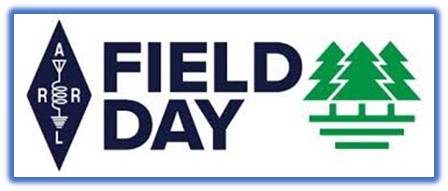
In previous articles we’ve discussed the point of the exercise as well as the basic rules. This post is about my favorite topic…Bonus Points! I belong to an amateur radio club that is about teaching, experimentation, and some socialization, so we don’t treat Field Day as a super serious contest. However, some of us are competitive and like to do what we can to earn our points. You can earn quite a few bonus points from a lot of different categories. Let’s discuss the different categories below.
The official rules per the ARRL are as follows:
7.3. Bonus Points: All stations are eligible for certain bonus points, depending on their entry class. The following bonus points will be added to the score, after the multiplier is applied, to determine the final Field Day score. Bonus points will be applied only when the claim is made on the summary sheet and any proof required accompanies the entry or is received via email or normal mail delivery.
7.3.1. 100% Emergency Power: 100 points per transmitter classification if all contacts are made only using an emergency power source up to a total of 20 transmitters (maximum 2,000 points). GOTA station and free VHF Station for Class A and F entries do not qualify for bonus point credit and should not be included in the club’s transmitter total. All transmitting equipment at the site must operate from a power source completely independent of the commercial power mains to qualify. (Example: a club operating 3 transmitters plus a GOTA station and using 100% emergency power receives 300 bonus points.) Available to Classes A, B, C, E, and F.
My group works entirely on emergency power from an Emergency Operations Center (EOC). That makes us Class F. We have a maximum of three transmitters at the same time; however, you can get up to 2,000 bonus points alone with this rule! With generators, batteries, and solar power available, there seems to be no reason not to pick up this fabulous bonus.
7.3.2. Media Publicity: 100 bonus points may be earned for obtaining publicity from the local media. A copy of the actual media publicity received (newspaper article, social media post, etc.) must be submitted to claim the points. Any combination of bona fide media hits would qualify for the bonus points. For example, posting the details of your upcoming or ongoing Field Day activity, or your Field Day results, as posted on a news media site (which could include the media site’s Facebook, Twitter, or Instagram) would meet the bonus criteria. Available to all Classes.
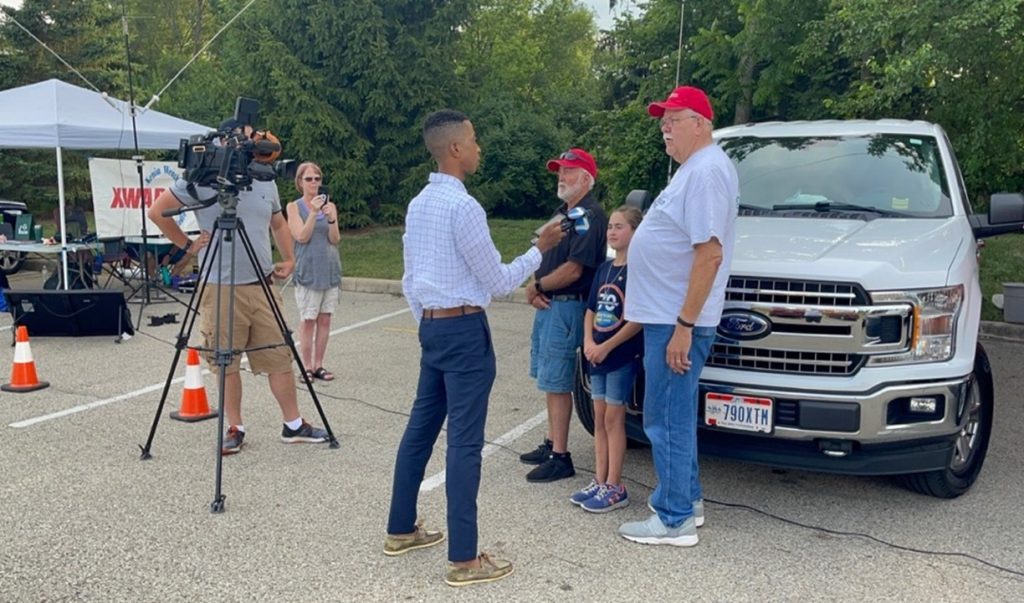
We invited our local television news channel to come out to our operation, as pictured above. They interviewed some of our members, including the younger ones. They aired a great segment on the 11 pm news and I was able to get a copy of it. This not only gains bonus points for our club but provides great publicity for our hobby. If you have this opportunity, I highly recommend it.
7.3.3. Public Location: 100 bonus points for physically locating the Field Day operation in a public place (i.e., shopping center, park, school campus). The intent is for amateur radio to be on display to the public. Available to Classes A, B and F.
Set up at a fire station, public park, county fairgrounds, etc., then advertise and welcome the public to stop by and see what Field Day is all about. You can share the love of our hobby and earn 100 bonus points!
7.3.4. Public Information Table: 100 bonus points for a Public Information Table at the Field Day site. The purpose is to make appropriate handouts and information available to the visiting public at the site. A copy of a visitor’s log, copies of club handouts or photos is sufficient evidence for claiming this bonus. Available to Classes A, B and F.
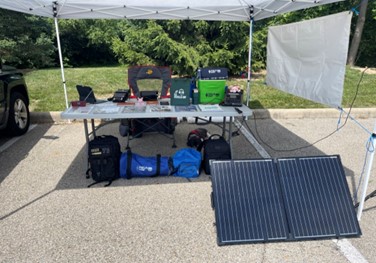
A Public Information Table can be filled with many things. The ARRL has a selection of pages and pamphlets that are completely free! These are great handouts to teach the public about amateur radio. It’s a good idea to put signs and items promoting Field Day on your table. You can make it as simple or as complex as you would like. A simple picture is worth 100 bonus points!
7.3.5. Message Origination to Section Manager: 100 bonus points for origination of a formal message to the ARRL Section Manager or Section Emergency Coordinator by your group from its site. You should include the club name, number of participants, Field Day location, and number of ARES operators involved with your station. The message must be transmitted during the Field Day period and a copy of it must be included in your submission in either standard NTS or ICS-213 format (or have the equivalent content) or no credit will be given. The message must leave or enter the Field Day operation via amateur radio RF.
The Section Manager message is separate from the messages handled in Rule 7.3.6. and may not be claimed for bonus points under that rule. Available to all Classes.
Winlink is a quick and simple way to send a message to your Section Manager. Otherwise send it through formal traffic channels. Another 100 points can be yours!
7.3.6. Message Handling: 10 points for each formal message originated, relayed or received and delivered during the Field Day period, up to a maximum of 100 points (ten messages). Copies of each message must be included with the Field Day report. The message to the ARRL SM or SEC under Rule 7.3.5. does not count toward the total of 10 for this bonus. Messages claimed under this bonus must be in either standard NTS or ICS-213 format (or have the equivalent content). All messages claimed for bonus points must leave or enter the Field Day operation via amateur radio RF. Available to all Classes.
Like to send traffic? Send, relay or receive during Field Day for some great bonus points. Just remember that your previous message to your Section Manager doesn’t count. No double dipping!
7.3.7. Satellite QSO: 100 bonus points for successfully completing at least one QSO via an amateur radio satellite during the Field Day period. “General Rules for All ARRL Contests” (Rule 3.7.2.), (the no-repeater QSO stipulation) is waived for satellite QSOs. Groups are allowed one dedicated satellite transmitter station without increasing their entry category. Satellite QSOs also count for regular QSO credit. Show them listed separately on the summary sheet as a separate “band.” You do not receive an additional bonus for contacting different satellites, though the additional QSOs may be counted for QSO credit unless prohibited under Rule 7.3.7.1. The QSO must be between two Earth stations through a satellite. Available to Classes A, B, and F.
7.3.7.1 Stations are limited to one completed QSO on any single channel FM satellite.
Get that elusive satellite contact for 100 bonus points! This can be a great training session to fit another bonus category coming up in a bit.
7.3.8. Alternate Power: 100 bonus points for Field Day groups making a minimum of five QSOs without using power from commercial mains or petroleum driven generator. This means an “alternate” energy source of power, such as solar, wind, methane or water. This includes batteries charged by natural means (not dry cells). The natural power transmitter counts as an additional transmitter. If you do not wish to increase your operating category, you should take one of your other transmitters off the air while the natural power transmitter is in operation. A separate list of natural power QSOs should be submitted with your entry. Available to Classes A, B, E, and F.
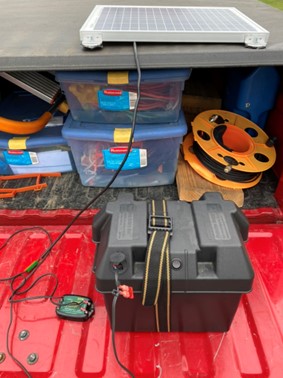
We chose to run off batteries recharged by solar as an alternate means of power. We then used this position to run the GOTA station. There are many options you can use to obtain these 100 bonus points.
7.3.9. W1AW Bulletin: 100 bonus points for copying the special Field Day bulletin transmitted by W1AW (or K6KPH) during its operating schedule during the Field Day weekend (listed in this rules announcement). An accurate copy of the message is required to be included in your Field Day submission. (Note: The Field Day bulletin must be copied via amateur radio. It will not be included in Internet bulletins sent out from Headquarters and will not be posted to Internet BBS sites.) Available to all Classes.
This is an easy 100 points. The schedule of when and where the bulletin will be is posted online for easy finding. I prefer to copy with one of the digital modes so it is already on the computer to send off to redeem the points. Maybe you can write faster than me, but if not, have a way to record the message handy to make sure you get the complete message.
7.3.10. Educational activity bonus: One (1) 100-point bonus may be claimed if your Field Day operation includes a specific educational-related activity. The activity can be diverse and must be related to amateur radio. It must be some type of formal activity. It can be repeated during the Field Day period but only one bonus is earned. For more information consult the FAQ in the complete Field Day packet. Available to Classes A & F entries and available clubs or groups operating from a club station in class D and E with 3 or more participants.
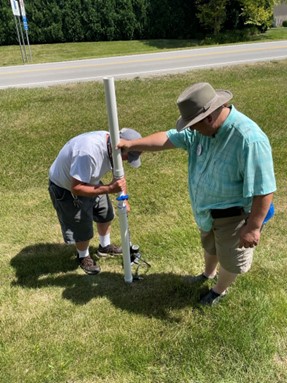
Try being an Elmer and teach an educational activity for 100 bonus points. This not only gives you bonus points but helps other amateurs learn something new. Field Day can be fun and educational.
7.3.11. Site visitation by an elected governmental official: One (1) 100-point bonus may be claimed if your Field Day site is visited by an elected government official as the result of an invitation issued by your group. Available to all Classes.
Invite the mayor, school board official, sheriff or county representative. Have them sit down and try making a contact. They might have a lot of fun and try for their own license. Plus, you get 100 bonus points.
7.3.12. Site visitation by a representative of an agency: One (1) 100-point bonus may be claimed if your Field Day site is visited by a representative of an agency served by ARES in your local community (American Red Cross, Salvation Army, local Emergency Management, law enforcement, etc.) as the result of an invitation issued by your group. ARRL officials (SM, SEC, DEC, EC, etc.) do not qualify for this bonus. Available to all Classes.
Since we set up at a fire station, we always invite a firefighter to join us. Local police are another good option. Have your Red Cross Liaison stop by and make a contact. Ask your county EMA director to pay a visit. Community outreach is a wonderful thing, plus those 100 bonus point are appreciated.
7.3.13. GOTA Bonus (UPDATED FOR 2023): Class A and F stations operating a GOTA station may earn the following bonus points:
7.3.13.1. Any successfully completed contacts made by an operator at the GOTA station are worth five (5) points, regardless of mode used. There is no limit to the number of contacts a single GOTA operator can make.
7.3.13.2. If a GOTA station is supervised full-time by a GOTA Coach, a single 100-point bonus will be earned.
7.3.13.2.1. The GOTA Coach supervises the operator of the station, doing such things as answering questions and talking them through contacts, but may not make QSOs or perform logging functions.
7.3.13.2.2. To qualify for this bonus, there must be a designated GOTA Coach present and supervising for at least 10 contacts.
The GOTA station bonus has changed drastically for 2023. Make sure to read it carefully. Get those amateurs who haven’t been on HF for years, the technicians, and the microphone-shy people who have never made a QSO to make as many as they can. Their contacts are worth good points!
7.3.14. Web submission: A 50-point bonus may be claimed by a group submitting their Field Day entry via the https://field-day.arrl.org/fdentry.php web app. Available to all Classes.
This is the easiest of all. Just do it.
7.3.15. Field Day Youth Participation:
7.3.15.1. A 20-point bonus (maximum of 100) may be earned by any Class A, C, D, E, or F group for each participant age 18 or younger at your Field Day operation that completes at least one QSO.
7.3.15.2. For a 1-person Class B station, a 20-point bonus is earned if the operator is age 18 or younger. For a 2-person Class B station, a 20-point bonus is earned for each operator age 18 or younger (maximum of 40 points.) Keep in mind that Class B is only a 1- or 2-person operation. This bonus does not allow the total number of participants in Class B to exceed 1 or 2.
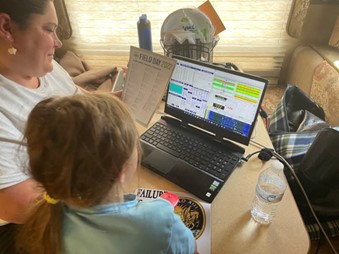
Gather as many young people as you can to make contacts. Even if there is a limit on how many bonus points they can earn, it is good to show them what fun amateur radio can be. Plus, their young voices get the QSOs easier!
7.3.16 Social Media: 100 points for promoting your Field Day activation to the general public via an active, recognized and utilized social media platform (Facebook, Twitter, Instagram, etc.). This bonus is available to bona fide amateur radio clubs and Field Day groups that welcome visitors to their operation. Individual participants do not qualify for this bonus. Club websites do not qualify for this bonus. Available to all classes.
Take pictures and put them on social media. Everyone loves to see your pictures and it makes a good advertisement for others to come visit. An easy 100 bonus points!
7.3.17 Safety Officer Bonus: A 100-point bonus may be earned by having a person serving as a Safety Officer for those groups setting up Class A stations. This person must verify that all safety concerns on the Safety Checklist (found in the ARRL Field Day Packet) have been adequately met. This is an active bonus–simply designating someone as Safety Officer does not automatically earn this bonus. A statement verifying the completion of the Safety Checklist must be included in the supporting documentation sent to ARRL HQ in order to claim this bonus. Available to Class A entries only.
Appoint one of your club members to be a safety officer. Print out the safety checklist and make sure the club is following the guidelines. Complete the whole checklist and you’ll receive another 100 points!
There are so many ways to get a lot of points on Field Day. I hope you will take advantage of the opportunities and add lots of points to your score. Happy Bonus Pointing!
Questions? Share them in the comments below or email me at KE8FMJ@gmail.com.

